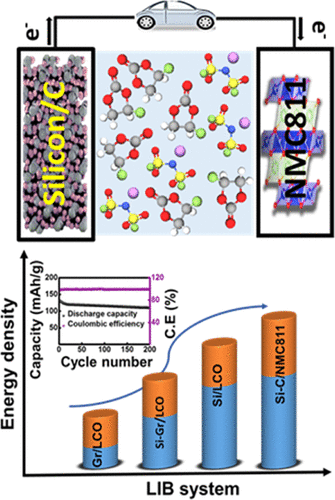当前位置:
X-MOL 学术
›
ACS Sustain. Chem. Eng.
›
论文详情
Our official English website, www.x-mol.net, welcomes your feedback! (Note: you will need to create a separate account there.)
Moderate-Concentration Fluorinated Electrolyte for High-Energy-Density Si//LiNi0.8Co0.1Mn0.1O2 Batteries
ACS Sustainable Chemistry & Engineering ( IF 8.4 ) Pub Date : 2020-10-22 , DOI: 10.1021/acssuschemeng.0c05560 Bharath Umesh, Purna Chandra Rath, Rahmandhika Firdauzha Hary Hernandha, Jeng-Yu Lin, Subhasish Basu Majumder, Quan-Feng Dong, Jeng-Kuei Chang
ACS Sustainable Chemistry & Engineering ( IF 8.4 ) Pub Date : 2020-10-22 , DOI: 10.1021/acssuschemeng.0c05560 Bharath Umesh, Purna Chandra Rath, Rahmandhika Firdauzha Hary Hernandha, Jeng-Yu Lin, Subhasish Basu Majumder, Quan-Feng Dong, Jeng-Kuei Chang

|
Highly concentrated electrolytes, although promising, are of high cost and show high viscosity and unsatisfactory wettability toward electrodes and separators, making them unfavorable for practical applications. A more rational electrolyte design is thus needed. Here, we investigate moderately concentrated electrolytes and find that the lithium bis(fluorosulfonyl)imide (LiFSI) concentration effects on the capacity, rate capability, and cycling stability of Si anodes in an ethylene carbonate (EC)/diethyl carbonate (DEC) mixed electrolyte are opposite to those in a fluoroethylene carbonate (FEC) electrolyte. The reasons for these results are systematically examined using Raman spectroscopy, transmission electron microscopy, electrochemical impedance spectroscopy, and the galvanostatic intermittent titration technique. A detailed X-ray photoelectron spectroscopy analysis is performed to study the solid electrolyte interphase chemistry. Al corrosion that occurs with the EC/DEC-based electrolyte can be effectively suppressed with the FEC-based electrolyte if an adequate LiFSI concentration is used. In the proposed 2 mLiFSI/FEC electrolyte, the Si anode has reversible capacities of 2630 and 855 mA h g–1 at 0.2 and 5 A g–1, respectively, and ∼75% capacity retention after 200 cycles (remarkably higher than that obtained with the EC/DEC-based electrolyte). This electrolyte also shows great compatibility with the high-energy-density LiNi0.8Co0.1Mn0.1O2 (NMC-811) cathode, allowing a stable charge–discharge of a Si//NMC-811 full cell.
中文翻译:

用于高能量密度Si // LiNi 0.8 Co 0.1 Mn 0.1 O 2电池的中浓度氟化电解质
高浓度的电解质尽管有希望,但是成本高并且显示出高粘度并且对电极和隔膜的润湿性不令人满意,从而使其不适用于实际应用。因此需要更合理的电解质设计。在这里,我们研究了中等浓度的电解质,发现双(氟磺酰基)酰亚胺(LiFSI)浓度对碳酸亚乙酯(EC)/碳酸二乙酯(DEC)混合电解质中硅阳极的容量,倍率能力和循环稳定性的影响与氟代碳酸亚乙酯(FEC)电解质中的相反。使用拉曼光谱,透射电子显微镜,电化学阻抗光谱和恒电流间歇滴定技术系统地检查了产生这些结果的原因。进行了详细的X射线光电子能谱分析,以研究固体电解质的相间化学。如果使用足够的LiFSI浓度,则基于FEC的电解质可以有效地抑制基于EC / DEC的电解质发生的Al腐蚀。在建议的2 mLiFSI / FEC电解质中,Si阳极具有2630和855 mA hg的可逆容量-1在0.2和5 A G -1,分别与200个周期(显着小于与基于DEC-EC /电解质获得更高)后〜75%的容量保持率。这种电解质还显示出与高能量密度LiNi 0.8 Co 0.1 Mn 0.1 O 2(NMC-811)阴极的高度相容性,从而使Si // NMC-811充满电的电池能够稳定地充放电。
更新日期:2020-11-02
中文翻译:

用于高能量密度Si // LiNi 0.8 Co 0.1 Mn 0.1 O 2电池的中浓度氟化电解质
高浓度的电解质尽管有希望,但是成本高并且显示出高粘度并且对电极和隔膜的润湿性不令人满意,从而使其不适用于实际应用。因此需要更合理的电解质设计。在这里,我们研究了中等浓度的电解质,发现双(氟磺酰基)酰亚胺(LiFSI)浓度对碳酸亚乙酯(EC)/碳酸二乙酯(DEC)混合电解质中硅阳极的容量,倍率能力和循环稳定性的影响与氟代碳酸亚乙酯(FEC)电解质中的相反。使用拉曼光谱,透射电子显微镜,电化学阻抗光谱和恒电流间歇滴定技术系统地检查了产生这些结果的原因。进行了详细的X射线光电子能谱分析,以研究固体电解质的相间化学。如果使用足够的LiFSI浓度,则基于FEC的电解质可以有效地抑制基于EC / DEC的电解质发生的Al腐蚀。在建议的2 mLiFSI / FEC电解质中,Si阳极具有2630和855 mA hg的可逆容量-1在0.2和5 A G -1,分别与200个周期(显着小于与基于DEC-EC /电解质获得更高)后〜75%的容量保持率。这种电解质还显示出与高能量密度LiNi 0.8 Co 0.1 Mn 0.1 O 2(NMC-811)阴极的高度相容性,从而使Si // NMC-811充满电的电池能够稳定地充放电。



























 京公网安备 11010802027423号
京公网安备 11010802027423号